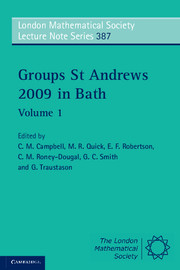Book contents
- Frontmatter
- Contents
- Introduction
- A speech in honour of John Cannon and Derek Holt
- Finite groups of Lie type and their representations
- Iterated monodromy groups
- Engel elements in groups
- Some classes of finite semigroups with kite-like egg-boxes of D-classes
- Structure of finite groups having few conjugacy class sizes
- Group theory in cryptography
- A survey of recent results in groups and orderings: word problems, embeddings and amalgamations
- A survey on the minimum genus and maximum order problems for bordered Klein surfaces
- On one-relator quotients of the modular group
- Miscellaneous results on supersolvable groups
- Automorphisms of products of finite groups
- A rational property of the irreducible characters of a finite group
- Automotives
- On n-abelian groups and their generalizations
- Computing with matrix groups over infinite fields
- Trends in infinite dimensional linear groups
- Engel conditions on orderable groups and in combinatorial problems (a survey)
- References
Computing with matrix groups over infinite fields
Published online by Cambridge University Press: 05 July 2011
- Frontmatter
- Contents
- Introduction
- A speech in honour of John Cannon and Derek Holt
- Finite groups of Lie type and their representations
- Iterated monodromy groups
- Engel elements in groups
- Some classes of finite semigroups with kite-like egg-boxes of D-classes
- Structure of finite groups having few conjugacy class sizes
- Group theory in cryptography
- A survey of recent results in groups and orderings: word problems, embeddings and amalgamations
- A survey on the minimum genus and maximum order problems for bordered Klein surfaces
- On one-relator quotients of the modular group
- Miscellaneous results on supersolvable groups
- Automorphisms of products of finite groups
- A rational property of the irreducible characters of a finite group
- Automotives
- On n-abelian groups and their generalizations
- Computing with matrix groups over infinite fields
- Trends in infinite dimensional linear groups
- Engel conditions on orderable groups and in combinatorial problems (a survey)
- References
Summary
Abstract
We survey currently available algorithms for computing with matrix groups over infinite domains. We discuss open problems in the area, and avenues for further development.
Introduction
The subject of linear groups is one of the main branches of group theory. Linear groups provide a link between group theory and natural sciences such as physics, chemistry, and genetics; as well as other areas of mathematics, including geometry, combinatorics, functional analysis, and differential equations.
The significance of linear groups was realized at the very beginning of group theory, dating back to work by C. Jordan (1870). In the early twentieth century, major successes in linear group theory were achieved by Burnside, Schur, Blichfeldt, and Frobenius; their results continue to exert an influence up to the present day.
Linear groups arise in various ways in the theory of abstract groups. For instance, they occur as groups of automorphisms of certain abelian groups, and they play a central role in the study of solvable groups. Furthermore, linearity is a vital property for some classes of groups: polycyclic-by-finite groups and countable free groups are prominent examples. Linear groups are closely associated to Lie groups, algebraic groups, and representation theory. For extra background we refer to [16, 48, 49, 50].
Advances in computational algebra have motivated a new phase in linear group theory. Matrix representations of groups have the advantage that a large (even infinite) group can be defined by input of small size.
- Type
- Chapter
- Information
- Groups St Andrews 2009 in Bath , pp. 256 - 270Publisher: Cambridge University PressPrint publication year: 2011
References
- 2
- Cited by

